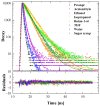Advanced Research on Biological Properties-A Study on the Activity of the Apis mellifera Antioxidant System and the Crystallographic and Spectroscopic Properties of 7-Diethylamino-4-hydroxycoumarin
- PMID: 40725260
- PMCID: PMC12295793
- DOI: 10.3390/ijms26147015
Advanced Research on Biological Properties-A Study on the Activity of the Apis mellifera Antioxidant System and the Crystallographic and Spectroscopic Properties of 7-Diethylamino-4-hydroxycoumarin
Abstract
The search for substances that increase the immunity of bees is becoming a necessity in the era of various environmental threats and the declining immunocompetence of these insects. Therefore, we tested the biological and physicochemical properties of 7-diethylamino-4-hydroxycoumarin (7DOC). In a cage test, two groups of bees were created: a control group fed with sugar syrup and an experimental group fed with sugar syrup with the addition of 7DOC. In each group, the longevity of the bees was determined and the protein concentrations and antioxidant activities in the bees' hemolymph were determined. The bees fed with 7DOC lived 2.7 times longer than those in the control group. The protein concentrations and activities of SOD, CAT, GPx and GST, as well as the TAC levels, were significantly higher in the hemolymph of the supplemented workers. To confirm these potent biological properties of 7DOC, the UV-Vis spectra, emission and excitation of fluorescence, synchronous spectra and finally the fluorescence lifetimes of this compound were measured using the time-correlated single photon counting method, in various environments differing in polarity and in the environment applied in bee research. This compound was shown to be sensitive to changes in solvent polarity. The spectroscopic assays were complemented with crystallographic tests of the obtained monocrystals of the aforementioned compounds, which attested to the aggregation effects observed in the spectra measurements for the selected coumarin. The research results confirm that this compound has the potential to be implemented in apiary management, which will be our application goal, but further research into apiary conditions is required.
Keywords: X-ray crystallography; antioxidants; coumarin derivatives; honeybee; molecular spectroscopy.
Conflict of interest statement
The authors declare no conflicts of interest.
Figures












Similar articles
-
The antioxidant system was unexpectedly strongly suppressed in apis mellifera worker bees emerged from larvae reared on combs adulterated with paraffin or stearin.Sci Rep. 2025 Jul 1;15(1):20363. doi: 10.1038/s41598-025-08596-w. Sci Rep. 2025. PMID: 40596282 Free PMC article.
-
The Lived Experience of Autistic Adults in Employment: A Systematic Search and Synthesis.Autism Adulthood. 2024 Dec 2;6(4):495-509. doi: 10.1089/aut.2022.0114. eCollection 2024 Dec. Autism Adulthood. 2024. PMID: 40018061 Review.
-
Self-management of oral anticoagulation therapy--methodological and clinical aspects.Dan Med Bull. 2011 May;58(5):B4284. Dan Med Bull. 2011. PMID: 21535992
-
Sertindole for schizophrenia.Cochrane Database Syst Rev. 2005 Jul 20;2005(3):CD001715. doi: 10.1002/14651858.CD001715.pub2. Cochrane Database Syst Rev. 2005. PMID: 16034864 Free PMC article.
-
Systemic pharmacological treatments for chronic plaque psoriasis: a network meta-analysis.Cochrane Database Syst Rev. 2021 Apr 19;4(4):CD011535. doi: 10.1002/14651858.CD011535.pub4. Cochrane Database Syst Rev. 2021. Update in: Cochrane Database Syst Rev. 2022 May 23;5:CD011535. doi: 10.1002/14651858.CD011535.pub5. PMID: 33871055 Free PMC article. Updated.
References
-
- De Paula J.C., Doello K., Mesas C., Kapravelou G., Cornet-Gómez A., Orantes F.J., Martínez R., Linares F., Prados J.C., Porres J.M., et al. Exploring Honeybee Abdominal Anatomy through Micro-CT and Novel Multi-Staining Approaches. Insects. 2022;13:556. doi: 10.3390/insects13060556. - DOI - PMC - PubMed
MeSH terms
Substances
LinkOut - more resources
Full Text Sources
Medical
Research Materials
Miscellaneous

